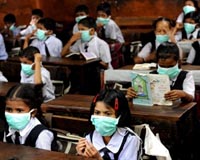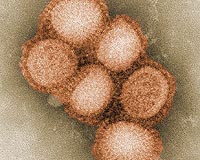 Vaccinate kids, parents to manage flu spread: study
Vaccinate kids, parents to manage flu spread: study

School closures to stem swine flu 'doesn't make sense': official
Canadian health authorities said Wednesday school closures do not prevent the spread of the swine flu, as students prepare to return to classes in September after a summer break. "The closing of schools, while theoretically may be helpful, as it turns out really doesn't help," David Butler-Jones, Canada's chief public health officer told a press conference. "At most it might buy you a few days and you can't keep schools closed for months," he said. And so, "widespread school closures are not recommended at this time," said Health Minister Leona Aglukkaq. This lesson was partly learned from efforts in South America to stem the spread of the virus. Argentina closed schools earlier this year to try to stem the spread of the A(H1N1) virus, while Chile did not "and Chile had as good an impact as did Argentina," said Butler-Jones. "If you close a school based on a few cases you're taking a controlled situation" in which you can teach students to wash their hands and take other preventive measures, and "you create an uncontrolled situation," he explained. "If, however, circumstances change and the disease becomes highly fatal in children, then we'd have to reconsider (our advice). But at the moment, closing of schools ... from a public health standpoint doesn't make sense," he said. To date, 67 deaths here have been attributed to the swine flu in recent months. Most new cases in Canada, however, "continue to be mild," said Aglukkaq. A vaccine is expected to be distributed in Canada by year-end, officials said. Photo courtesy AFP. |
by Staff Writers
Washington Aug 20, 2009
Targeting vaccines to school-age children and their parents could help manage potential outbreaks of swine and seasonal flu and avert worrisome vaccine shortages, researchers suggested on Thursday.
The study in the August 21 issue of the journal Science comes as the Northern Hemisphere braces for the start of its influenza season in the coming months, while deaths from swine flu mount in countries where it is winter.
The approach runs counter to typical recommendations to battle seasonal flu, which urge the vaccination of children under five as well as all people over the age of 50, noted study coauthor Jan Medlock, a mathematician at Clemson University in South Carolina.
But "vaccines would be better used to prevent transmission within schools and out to parents, who then spread the flu to the rest of the population," Medlock said.
His research used a mathematical model to demonstrate cases of flu spreading in which limited vaccine doses were given to school-aged children and adults age 30-39 -- parents in contact with the students.
Looking at the influenza pandemics of 1918 and 1957, researchers determined that even with just 63 million doses of vaccine, they could be given first to children 5-19, the group in which the greatest amount of spreading takes place, and adults 30-39, most often infected by their children.
Following the traditional protocols, the United States uses more than 80 million doses of seasonal flu vaccine every year to combat influenza, which kills about 36,000 Americans annually.
But faced with the swine flu, or (A)H1N1 global pandemic, which has already killed 1,799 people worldwide according to the World Health Organization, experts have raised concerns about the availability of enough vaccine to administer to at-risk groups.
In July, the Centers for Disease Control (CDC) said children and pregnant women should be among the first to receive a swine flu vaccine, and warned that the total at-risk population would number around 160 million.
Those targets also include caretakers and others in contact with children under six months old, healthcare workers, youths between the ages of six months and 24 years, and adults with underlying medical conditions.
Officials at that time forecast a shortage of vaccines, with only 120 million doses likely to be available by October.
But in August, US health officials issued a more dire warning that only 45 million swine flu doses would be ready by mid-October, with 20 million doses delivered each week thereafter.
The WHO has forecast possible shortages in the production of (A)H1N1 vaccines this year due to the slow growth of the swine-origin (A)H1N1 in chicken eggs.
Unlike seasonal flu, which usually hits elderly people the hardest, the (A)H1N1 virus has mostly infected the young. It emerged in Mexico in April and has since spread to 170 countries.
Deaths from swine flu in Latin America -- the worst-hit region in the world -- rose to more than 1,300 this week after governments added to tolls from the disease.
South America has seen the (A)H1N1 flu spread widely during its southern hemisphere winter. In several countries, it has overtaken ordinary seasonal flu.
And with vaccines against swine flu still more than a month away from being available -- and wealthy countries snapping up all available pre-orders from the big drug companies -- Latin American nations are looking at ignoring patents to produce their own.
Worldwide, there have been 177,457 confirmed cases of swine flu, according to the World Health Organization.
More than two million people have probably been infected by the swine flu virus in the United States, including 7,511 who have been hospitalized and 477 who have died, according to the most recent figures of the Centers for Disease Control and Prevention.
Share This Article With Planet Earth
Related Links
Epidemics on Earth - Bird Flu, HIV/AIDS, Ebola

 Latin America swine flu deaths climb to 1,300
Latin America swine flu deaths climb to 1,300
Sao Paulo (AFP) Aug 19, 2009
Deaths from swine flu in Latin America -- the worst-hit region in the world -- rose to over 1,300 on Wednesday after governments added to tolls from the disease. Brazil late Tuesday said its count climbed to 368 deaths, putting it just behind Argentina which, with 404 deaths, has the second-highest fatality tally in the world. The United States has 477 deaths. South America has seen the ... read more
|
 |
|

 Latin America swine flu deaths climb to 1,300
Latin America swine flu deaths climb to 1,300